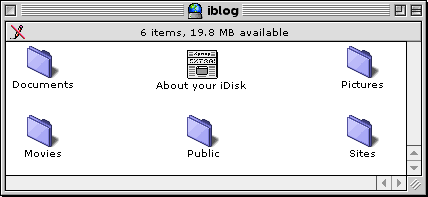The Keeper of the iBookBehind the ScenesBy Mark Newhouse, <ibook_keeper@mac.com> I taught school for six and a half years. One thing I learned was that if someone asked a question, there were at least 3 or 4 other students who had the same, or similar question. I've had the same question asked about the Keeper of the iBook three times now. Given the number of readers that I have, I am sure there are more that have the same question, but just haven't gotten around to asking, yet. And the question is?How do you use your own design on the homepage.mac.com space provided by Apple? And the answer is:Really pretty straightforward, actually. Put whatever you want in the Sites folder on your iDisk. What's an iDisk?Glad you asked, or this week's article would have been pretty short. An iDisk is one of Apple's iTools. You get one by signing up for their iTools, and along the way you also pick up an email@mac.com email address. The iDisk is an Internet accessible shared volume (like file sharing over the internet). Your iTools account includes 20 MB of server space, for free. You can put anything you want in your iDisk, including HTML and image files that are accessible at homepage.mac.com/your_log-in_name/. Neat, huh? Oh, you need MacOS 9 to access iTools. At least according to Apple you do. Actually iDisks have been seen on 68K Macs running System 7.6. I happen to be using OS 8.6. To find out how, go to this iTools Trick page. This page has a link to the sign-up page, as well as information on how to update your file sharing software to take advantage of your iDisk. Once you have your account, you can access your iDisk the same way you would mount a server on your LAN or home network. Open the Chooser from the Apple menu. Click AppleShare. Then click the Server IP Address... button. Type idisk.mac.com as the server address and click Connect. After a few seconds (or more if you are on a dial-up) the standard log-in dialog will appear and you type in your iTools username and password. A few seconds later an iDisk will appear on your desktop. Once you have mounted your iDisk it will appear as an alias in your Recent Servers folder (if you've enabled that in the Apple Menu Options control panel) 
Open up your iDisk and you'll see several folders, including Public, Pictures, Movies, and Sites. Simply move any HTML files and images that you want to appear on homepage.mac.com/your_username/ into the Sites folder (drag and drop - wheee!). Use index.html as the default file. You can't add folders to the Sites folder (maybe you can, but whatever you put in it won't be accessible via the web), everything has to go into the top level of the Sites folder. [UPDATE: this is wrong information! You can create new folders, and the contents of those folders will be accessible via the web. I've tried two folders deep, and everything worked. Thanks for getting me the correct information Kevin!] So, that is how to use your own HTML and image files on your homepage.mac.com web site. And as long as Apple keeps it "annoying pop-up/banner free," I'll keep hosting this site there. Of hits and access logsAlthough I am writing these articles because I enjoy it, I am also interested in how many people are visiting my site, breathlessly awaiting my next article. Apple doesn't (to my knowledge) provide a way to track visits to your homepage.mac.com site, so I had to figure out a workaround. I am fortunate enough to have a computer at work that is connected to the internet 24/7 via a T1 ethernet line, with a dedicated ip address. So I decided to use Apple's built-in Web Sharing software to help me track hits to the sites. I have created a single pixel, invisible gif file that has a unique name for each page. So the HTML file for this page calls one of these gifs from my work machine (A G4), called k13.gif. Every time this page is loaded, the Web Sharing software registers it in its rudimentary log, along with the ip address of the computer that visited, and the date and time of the visit. But this log, and ascii file, quickly becomes tedious to look at. So I downloaded a free piece of software called Analog that analyzes web log files. This generates a report in HTML that I can look at to see that my Keeper of the iBook column called Surf Naked has received more hits than any of the other columns (not sure why...). Pay no attention to the man behind the curtain... Mark Newhouse is the Web Designer for the public outreach arm of the National Optical Astronomy Observatories in Tucson, AZ, where he gets paid to do what he enjoys. How cool is that? The iBook image is courtesy Apple Computer, Inc. The iBook icon is courtesy the Iconfactory. |
|
Keeper of the iBook Copyright © 2000, Mark Newhouse, all rights reserved

